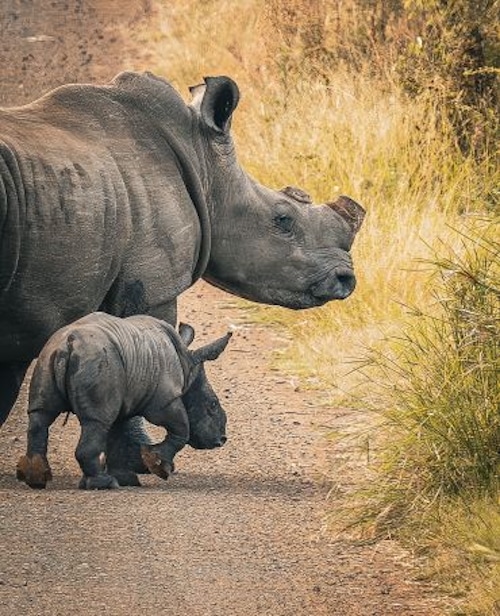This post was originally published on Eco Watch
Removing the horns of rhinoceros has been found to be an effective way to drastically reduce poaching of the endangered mammals.
A new study by an international team of researchers found that dehorning results in 78 percent less poaching while using a tiny fraction of the total protection budget.
“Despite decades of conservation efforts, poaching for international trade continues to threaten the existence of the world’s five rhinoceros species while also reducing tourism revenues, entrenching criminal syndicates, threatening ecosystem function, and leading to loss of human life due to violent contacts between rangers and poachers,” the authors wrote in the findings of the study.
The research team looked at data from 11 nature reserves in South Africa’s Greater Kruger region between 2017 and 2023. The landscape is a crucial stronghold that protects roughly 25 percent of all rhinos in Africa, a press release from University of Oxford said.
During the seven-year study period, approximately 6.5 percent of the rhino population in the Greater Kruger area — 1,985 rhinos — was poached annually.
“Dehorning rhinos to reduce incentives for poaching (2,284 rhinos were dehorned across eight reserves) was found to achieve a 78% reduction in poaching using just 1.2% of the overall rhino protection budget,” said lead author of the study Dr. Tim Kuiper, an African biodiversity scientist with Nelson Mandela University, in the press release.
A dehorned white rhino mother and calf in the Greater Kruger region. Tim Kuiper
The figure was based on a comparison between sites that incorporated dehorning and those that did not, as well as poaching changes before and after dehorning.
The results showed that there was still some poaching of rhinos who had been dehorned for their horn stumps, as well as regrowth. More recent evidence from 2024 and 2025 suggests that this is an increasing problem. Dehorning could also shift poachers’ focus to populations of horned rhinos in other areas.
“This study has important implications, not just for rhino management, but also more broadly for conservationists planning and implementing interventions. It also suggests that it is worth thinking of ways to reduce the expected profitability of poaching (in this case through dehorning), rather than only focusing on increasing the expected risks and costs,” said co-author of the study E.J. Milner-Gulland, a professor of biodiversity at University of Oxford.
The reserves assessed in the study invested $74 million in anti-poaching methods from 2017 to 2021. Most of these interventions were focused on rangers, detection cameras, tracking dogs, helicopters and access controls, and resulted in more than 700 arrests of poachers. However, the researchers did not find any statistical evidence that the efforts significantly reduced poaching.
“Interventions that work to aid poacher detection and arrest, while a necessary element of the anti-poaching toolkit, are compromised by systemic factors, such as local poverty (driving people to take risks) and corruption. Ineffective criminal justice systems can also mean that arrested offenders often escape punishment,” the press release said.
The project was initially conceived by reserve managers who recognized the need for a critical evaluation of their investments in anti-poaching tactics — from AI cameras to tracking dogs. The Greater Kruger Environmental Protection Foundation (GKEPF) spearheaded the initiative by holding manager workshops and compiling data.
“This collaboration is a brilliant example of how the effectiveness of conservation interventions can be assessed quantitatively, even in challenging and complex situations, and how important the participation of on-the-ground practitioners is in initiating, and interpreting, such research,” Milner-Gulland said.
The results of the study provide an opportunity for governments, NGOs, funders and the private sector to reevaluate their approaches to wildlife crime, in particular rhino poaching.
“The true value of this innovative study, conceived by GKEPF operational managers, lies in its collective critical thinking. Ensuring not only that operations are guided by science, but also that science is grounded in real experience from the frontline,” said CEO of GKEPF Sharon Hausmann.
The study, “Dehorning reduces rhino poaching,” was published in the journal Science.
The post Dehorning Rhinos Reduces Poaching by Nearly 80%: Study appeared first on EcoWatch.





0 Comments